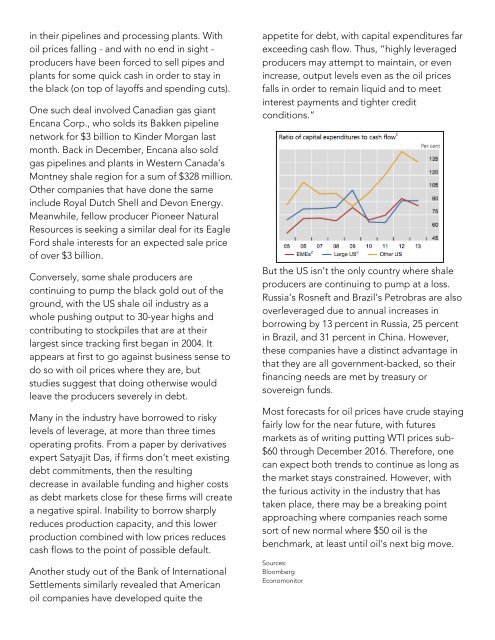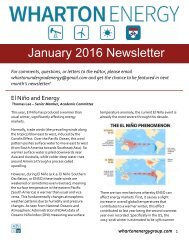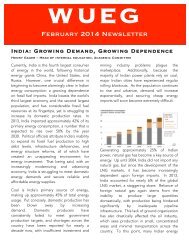You also want an ePaper? Increase the reach of your titles
YUMPU automatically turns print PDFs into web optimized ePapers that Google loves.
in their pipelines and processing plants. With<br />
oil prices falling - and with no end in sight -<br />
producers have been forced to sell pipes and<br />
plants for some quick cash in order to stay in<br />
the black (on top of layoffs and spending cuts).<br />
One such deal involved Canadian gas giant<br />
Encana Corp., who solds its Bakken pipeline<br />
network for $3 billion to Kinder Morgan last<br />
month. Back in December, Encana also sold<br />
gas pipelines and plants in Western Canada’s<br />
Montney shale region for a sum of $328 million.<br />
Other companies that have done the same<br />
include Royal Dutch Shell and Devon Energy.<br />
Meanwhile, fellow producer Pioneer Natural<br />
Resources is seeking a similar deal for its Eagle<br />
Ford shale interests for an expected sale price<br />
of over $3 billion.<br />
Conversely, some shale producers are<br />
continuing to pump the black gold out of the<br />
ground, with the US shale oil industry as a<br />
whole pushing output to 30-year highs and<br />
contributing to stockpiles that are at their<br />
largest since tracking first began in 2004. It<br />
appears at first to go against business sense to<br />
do so with oil prices where they are, but<br />
studies suggest that doing otherwise would<br />
leave the producers severely in debt.<br />
Many in the industry have borrowed to risky<br />
levels of leverage, at more than three times<br />
operating profits. From a paper by derivatives<br />
expert Satyajit Das, if firms don’t meet existing<br />
debt commitments, then the resulting<br />
decrease in available funding and higher costs<br />
as debt markets close for these firms will create<br />
a negative spiral. Inability to borrow sharply<br />
reduces production capacity, and this lower<br />
production combined with low prices reduces<br />
cash flows to the point of possible default.<br />
Another study out of the Bank of International<br />
Settlements similarly revealed that American<br />
oil companies have developed quite the<br />
appetite for debt, with capital expenditures far<br />
exceeding cash flow. Thus, “highly leveraged<br />
producers may attempt to maintain, or even<br />
increase, output levels even as the oil prices<br />
falls in order to remain liquid and to meet<br />
interest payments and tighter credit<br />
conditions.”<br />
But the US isn’t the only country where shale<br />
producers are continuing to pump at a loss.<br />
Russia’s Rosneft and Brazil’s Petrobras are also<br />
overleveraged due to annual increases in<br />
borrowing by 13 percent in Russia, 25 percent<br />
in Brazil, and 31 percent in China. However,<br />
these companies have a distinct advantage in<br />
that they are all government-backed, so their<br />
financing needs are met by treasury or<br />
sovereign funds.<br />
Most forecasts for oil prices have crude staying<br />
fairly low for the near future, with futures<br />
markets as of writing putting WTI prices sub-<br />
$60 through December 2016. Therefore, one<br />
can expect both trends to continue as long as<br />
the market stays constrained. However, with<br />
the furious activity in the industry that has<br />
taken place, there may be a breaking point<br />
approaching where companies reach some<br />
sort of new normal where $50 oil is the<br />
benchmark, at least until oil’s next big move.<br />
Sources:<br />
Bloomberg<br />
Economonitor









